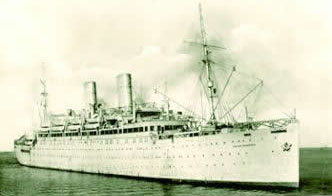Conversation Windrush
Comment: The forgotten journey of the Windrush
Published on: 14 June 2018
Writing for The Conversation, Professor James Procter discusses how he discovered a document which sheds new light on the history of the Empire Windrush.

When the Empire Windrush docked at Tilbury in Essex on June 22, 1948 it was carrying a crowded cargo of around 500 West Indian settlers dressed in their Sunday best. Britain is marking the 70th anniversary of that now legendary story of arrival, which is said to herald the beginning of postwar mass migration to Britain.
But like most beginnings, this one isn’t as clear as it seems.
The Windrush was not the first ship carrying West Indian migrants to Britain in the 1940s – for example, the Ormonde and the Almanzora arrived in 1947. We know, thanks to historians such as Peter Fryer – himself a reporter on the Windrush story as it broke – that the history of black settlement in this country goes back at least as far as Roman times. We also know, due to Britain’s long overseas past as a slaving nation, that, as the Barbadian novelist George Lamming put it in 1960: “We (Britons and West Indians) have met before.”
But what of the immediate history of the Windrush, after the former German troopship was commandeered by the British, and before its legendary voyage from Jamaica to Tilbury? When it is mentioned at all, accounts locate it somewhere in the Atlantic, en route from Australia to Britain.
So it was with a sense of surprise and déjà vu that I came across a short news report in the BBC’s Written Archives that places the ship elsewhere.
Airmen repatriated
Broadcast from London to the Caribbean in April 1948, the BBC script opens:
The Colonial Office have announced that the last big draft of airmen for repatriation will sail from Tilbury on May 8th on the Empire Windrush.
The radio broadcast continues:
The Officers-in-Charge will be Flight Lieutenant Johnny Smythe, a West African who still carries around several bits of shrapnel in his lungs and side from his war service and Flight Lieutenant J.J. Blair of Jamaica who won the DFC.
The DFC is the Distinguished Flying Cross which is awarded to Royal Air Force personnel for acts of valour, courage or devotion.
This voyage out took place just weeks before the Windrush entered history, when it sailed in the opposite direction from the Caribbean to Tilbury. The 500 “ordinary airmen” on board had, according to the broadcast, recently completed a variety of vocational training courses in engineering, welding, accountancy and “dental mechanics”. All were reportedly keen to get back to their respective homes in Jamaica, British Guiana, Trinidad, Barbados, British Honduras and Antigua. They were among the last of around 10,000 or so West Indian service men and women recruited during World War II to return to the Caribbean.
Delivered by the West Indian cricketer, Bertie Clarke, the broadcast script closes by saying: “The journey will be Jamaica, Trinidad, on to Bermuda and then back to England.” It is this last leg of the journey back to England that currently frames our understanding of the Windrush as a voyage in.
A story of arrival and departure
The discovery of this previously unknown document about the ship’s outward voyage invites a re-think of the Windrush story, from the other direction. Before it “arrived” in official history, the Windrush was already here. Its journey is more directly implicated in Britain’s domestic post-war past than we have so far recognised.
The neglected BBC report is just one small example of a much more pervasive and deep-seated amnesia that is, paradoxically, central to British national memory. It is a story of heroic presence and determined participation that begs to be set alongside Prime Minister Theresa May’s “hostile environment” policy on immigration. It is a story which the recent treatment of the Windrush generation shows, goes on being forgotten.
Perhaps part of the reason this pre-history of the ship’s otherwise richly documented journey has been forgotten, is that the now famous story of its arrival is more convenient than the neglected story of its departure. If the legend of the Windrush’s arrival involves a narrative of colonial dependency in which the Caribbean is a grateful beneficiary, the story of its departure points to Britain’s dependence on its empire during the darkest days of World War II.
Another more technical reason is that the newly unearthed broadcast was never aired in Britain. The BBC’s Home Service documents only the story of the Windrush’s arrival. The story of its prior departure just a few weeks before was broadcast externally, on the Colonial Service, and has remained out of earshot ever since.
The history of the Windrush is a multi-directional one and should be remembered as such: a voyage in, as well as a voyage out.
James Procter, Professor of Modern and Contemporary Literature, Newcastle University
This article was originally published on The Conversation. Read the original article.



